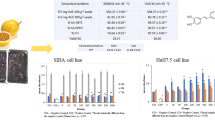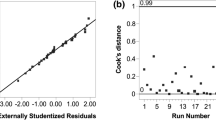Abstract
Stone-fruit liqueurs contain high contents of the carcinogen ethyl carbamate (EC). In this study, we investigated the effect of plum fruit extract and single antioxidants present in plum fruit extracts on the reduction in the EC content during the macerating process in a plum liqueur model system and authentic plum liqueur. 30% ethanol model plum liqueur treated with 0.2% plum extract showed the lowest EC content with 55% reduction rate after the macerating process compared to the content in the control. Interestingly, neither 0.1% ascorbic acid nor 0.1% p-coumaric acid lowered the EC contents in the model liqueur, while they decreased the EC contents in authentic plum liqueur. This was possibly attributed to the synergistic effect of the plum fruit phenolics with the ascorbic acid and p-coumaric acid antioxidants. Thus, plum extracts can be applied to plum liqueurs to reduce the rate of EC formation.



Similar content being viewed by others
References
Abt E, Incorvati V, Robin LP, Redan BW. Occurrence of ethyl carbamate in foods and beverages: Review of the formation mechanisms, advances in analytical methods, and mitigation strategies. Journal of Food Protection. 84: 2195-2212 (2021)
AOAC. Official method of analysis AOAC Intl. 17th ed. Method 994.07. Association of Official Analytical Chemists. (1997)
Ben Said R, Hamed AI, Mahalel UA, Al-Ayed AS, Kowalczyk M, Moldoch J, Oleszek W, Stochmal, A. Tentative characterization of polyphenolic compounds in the male flowers of phoenix dactylifera by liquid chromatography coupled with mass spectrometry and DFT. International Journal of Molecular Sciences. 18: 512 (2017)
Benucci I, Fiorelli V, Lombardelli C, Liburdi K, Esti M. Kinetic characterization of arginase from Saccharomyces cerevisiae during alcoholic fermentation at different temperatures. LWT-Food Science and Technology. 82: 268-273 (2017)
Bolarinwa IF, Orfila C, Morgan, MR. Amygdalin content of seeds, kernels and food products commercially-available in the UK. Food chemistry, 152: 133-139 (2014)
Cho JW, Kim, BY, Jeong JB, Kim HS. Changes in amygdalin contents and characteristics of maesil (Prunus mume) liqueur during leaching and ripening. Korean Journal of Food Science and Technology. 50: 697-700 (2018)
Cho CW, Park YS, Yan XT, Kim HJ, Kim YH, Kim KT, Men CV, Kang JS. Quantitation of phenolic compounds related to antioxidant and antiosteoporosis activities in ripe and unripe maesil (Prunus mume). Journal of Food Quality. 1-13 (2020)
CODEX Ailmentarius Commission. CAC/GL 37-2001 harmonised guidelines for the use of recovery information in analytical measurement. (2001)
Rural Development of Administration (RDA). Functional component search. Available at: http://koreanfood.rda.go.kr/kfi/fct/fctPhenolSrch/list. Accessed Nov. 4, 2020.
Food Standards Australia New Zealand (FSANZ). Ethyl carbamate in Australian foods. (2007)
Gowd V, Su H, Karlovsky P, Chen W. Ethyl carbamate: An emerging food and environmental toxicant. Food Chemistry. 248: 312-321 (2018)
Hammoda HM, Ghazy NM, Harraz FM, Radwan MM, ElSohly MA, Abdallah II. Chemical constituents from Tribulus terrestris and screening of their antioxidant activity. Phytochemistry. 92: 153-159 (2013)
Hashiguchi T, Horii S, Izu H, Sudo, S. The concentration of ethyl carbamate in commercial ume (Prunus mume) liqueur products and a method of reducing it. Bioscience, Biotechnology, and Biochemistry. 74: 2060-2066 (2010)
Hoffler U, El-Masri HA, Ghanayem BI. Cytochrome P450 2E1 (CYP2E1) is the principal enzyme responsible for urethane metabolism: comparative studies using CYP2E1-null and wild-type mice. Journal of Pharmacology and Experimental Therapeutics. 305: 557-564 (2003)
ICH Harmonised Tripartite Guideline. Validation of analytical procedures; text and methodology Q2(R1). International conference on harmonisation of technical requirements for registration of pharmaceuticals for human use, Geneva, pp. 1–13 (2005)
Iglesias-Carres L, Mas-Capdevila A, Bravo FI, Aragonès G, Arola-Arnal A, Muguerza BA. A comparative study on the bioavailability of phenolic compounds from organic and nonorganic red grapes. Food Chemistry. 299: 125092 (2019)
JECFA. Joint FAO/WHO expert committee on food additives. Evaluation of certain food contaminants: sixty-fourth report of the Joint FAO/WHO expert committee on food additives (2006)
Jung S, Kim S, Kim I, Chung M-S, Moon B, Shin S, Lee J. Risk assessment of ethyl carbamate in alcoholic beverages in Korea using the margin of exposure approach and cancer risk assessment. Food Control. 124: 107867 (2021)
Kiliç I, Yeşiloğlu Y. Spectroscopic studies on the antioxidant activity of p-coumaric acid. Spectrochimica Acta Part A: Molecular and Biomolecular Spectroscopy. 115: 719-724 (2013)
Kim N-Y, Eom M-N, Do Y-S, Kim J-B, Kang S-H, Yoon M-H, Lee J-B. Determination of ethyl carbamate in maesil wine by alcohol content and ratio of maesil (Prunus mume) during ripening period. Korean Journal of Food Preservation. 20: 429-434 (2013)
Kim J-H, Cho H-D, Won Y-S, Park W-L, Min H-J, Han S-H, Moon K-D, Seo K-I. Antioxidant and α-glucosidase inhibition activity of solvent fractions from Prunus mume ethanol extract. Journal of Life Science. 29: 1111-1119 (2019)
Koontz JL, Liggans GL, Redan BW. Temperature and pH affect copper release kinetics from copper metal foil and commercial copperware to food simulants. Food Additives & Contaminants: Part A. 37: 465-477 (2020).
Lachenmeier DW, Schehl B, Kuballa T, Frank W, Senn T. Retrospective trends and current status of ethyl carbamate in German stone-fruit spirits. Food Additives and Contaminants. 22: 397-405 (2005)
Lachenmeier DW, Kanteres F, Kuballa T, López M, Rehm J. Ethyl carbamate in alcoholic beverages from Mexico (tequila, mezcal, bacanora, sotol) and Guatemala (cuxa): Market survey and risk assessment. International Journal of Environmental Research and Public Health. 6: 349-360 (2009)
Lee S-H, Park L-Y, Chae M-H. Effects of alcohol concentration on quality changes of Maesil (Prunus mume) liqueur during leaching and ripening. Korean Journal of Food Preservation. 14: 552-556 (2007)
Leithauser MT, Liem A, Stewart BC, Miller EC, Miller JA. 1,N6 formation, mutagenicity and murine tumor induction as indicators of the generation of an electrophilic epoxide metabolite of the closely related carcinogens ethyl carbamate (urethane) and vinyl carbamate. Carcinogenesis. 11: 463-473 (1990)
Martínez-Busi M, Arredondo F, González D, Echeverry C, Vega-Teijido MA, Carvalho D, Rodríguez-Haralambides A, Rivera F, Dajas F, Abin-Carriquiry JA. Purification, structural elucidation, antioxidant capacity and neuroprotective potential of the main polyphenolic compounds contained in Achyrocline satureioides (Lam) DC (Compositae). Bioorganic & Medicinal Chemistry. 27: 2579-2591 (2019)
Ministry of Food and Drug Safety (MFDS). Reduction Manual of ethyl carbamate in alcoholic beverages. 2011
Ministry of Food and Drug Safety (MFDS). Korea food additives code. 2023
Mira de Orduña R, Liu S-Q, Patchett M, Pilone G. Ethyl carbamate precursor citrulline formation from arginine degradation by malolactic wine lactic acid bacteria. FEMS Microbiology Letters. 183: 31-35 (2000)
Mitani T, Horinishi A, Kishida K, Kawabata T, Yano F, Mimura H, Inaba N, Yamanishi H, Oe T, Negoro K, Mori H, Miyake Y, Hosoda A, Tanake Y, Mori M, Ozaki Y. Phenolics profile of mume, Japanese apricot (Prunus mume Sieb. et Zucc.) fruit. Bioscience, Biotechnology, and Biochemistry. 77: 1623-1627 (2013)
Nóbrega IC, Pereira GE, Silva M, Pereira EV, Medeiros MM, Telles DL, Albuquerque Jr EC, Oliveira JB, Lachenmeier DW. Improved sample preparation for GC–MS–SIM analysis of ethyl carbamate in wine. Food Chemistry. 177: 23-28 (2005)
Park K-K, Liem A, Stewart BC, Miller JA. Vinyl carbamate epoxide, a major strong electrophilic, mutagenic and carcinogenic metabolite of vinyl carbamate and ethyl carbamate (urethane). Carcinogenesis. 14: 441-450 (1993)
Ryu D, Koh E. Determination of ethyl carbamate in commercial and homemade Maesilju. Journal of the East Asian Society of Dietary Life. 25: 309-315 (2015)
Sakano K, Oikawa S, Hiraku Y, Kawanishi S. Metabolism of carcinogenic urethane to nitric oxide is involved in oxidative DNA damage. Free Radical Biology and Medicine. 33: 703-714 (2002)
Sánchez-Camargo ADP, García-Cañas V, Herrero M, Cifuentes A, Ibáñez E. Comparative study of green sub-and supercritical processes to obtain carnosic acid and carnosol-enriched rosemary extracts with in vitro anti-proliferative activity on colon cancer cells. International Journal of Molecular Sciences. 17: 2046 (2016)
Senica M, Stampar F, Veberic R, Mikulic-Petkovsek M. Transition of phenolics and cyanogenic glycosides from apricot and cherry fruit kernels into liqueur. Food Chemistry. 203: 483-490 (2016)
Seo HJ,Yim SH, Song JH. Antioxidant activity of major cultivars Prunus mume in Korea. Korean Journal of Agricultural Science. 26: 477-488 (2018).
Son SJ, Jeong YJ, Kim SY, Choi JH, Kim NY, Lee H-S, Bae JM, Kim S-I, Lee H-S, Shin JS, Hans JS. Analysis of amygdalin of content Prunus mume by variety, harvest time, and fermentation conditions. Journal of the Korean Society of Food Science and Nutrition. 46: 721-729 (2017)
Varvara M, Bozzo G, Celano G, Disanto C, Pagliarone CN, Celano GV. The use of ascorbic acid as a food additive: technical-legal issues. Italian Journal of Food Safety 5: 4313 (2016)
You B, Yang S, Yu J, Xian W, Deng Y, Huang W, Li W, Yang R. (2021). Effect of thermal and dry salt-curing processing on free and bound phenolics and antioxidant activity in Prunus mume fruits together with the phenolic bioaccessibility. LWT. 145: 111355 (2021)
Zhao Y-y. Amygdalin content in four stone fruit species at different developmental stages. Science Asia. 38: 218-222 (2012)
Zhao X, Du G, Zou H, Fu J, Zhou J, Chen J. (2013). Progress in preventing the accumulation of ethyl carbamate in alcoholic beverages. Trends in Food Science & Technology. 32: 97-107 (2013)
Zhou K, Patrignani F, Sun, Y-M., Lanciotti R, Xu Z-L. Inhibition of ethyl carbamate accumulation in soy sauce by adding quercetin and ornithine during thermal process. Food chemistry. 343: 128528 (2021)
Acknowledgements
This research was supported by the National Research Foundation of Korea (NRF) funded by the Korea government (MSIP) [Grant Number NRF-2019R1F1A1062634]. This research was supported by the Chung-Ang University Graduate Research Scholarship in 2022.
Author information
Authors and Affiliations
Corresponding authors
Ethics declarations
Conflict of interest
The authors have no conflicts of interest to declare.
Additional information
Publisher's Note
Springer Nature remains neutral with regard to jurisdictional claims in published maps and institutional affiliations.
Supplementary Information
Below is the link to the electronic supplementary material.
Rights and permissions
Springer Nature or its licensor (e.g. a society or other partner) holds exclusive rights to this article under a publishing agreement with the author(s) or other rightsholder(s); author self-archiving of the accepted manuscript version of this article is solely governed by the terms of such publishing agreement and applicable law.
About this article
Cite this article
Jung, S., Lee, H., Kim, I. et al. The effect of plum extracts and antioxidants on reduction of ethyl carbamate in plum liqueur. Food Sci Biotechnol (2024). https://doi.org/10.1007/s10068-024-01585-1
Received:
Revised:
Accepted:
Published:
DOI: https://doi.org/10.1007/s10068-024-01585-1




